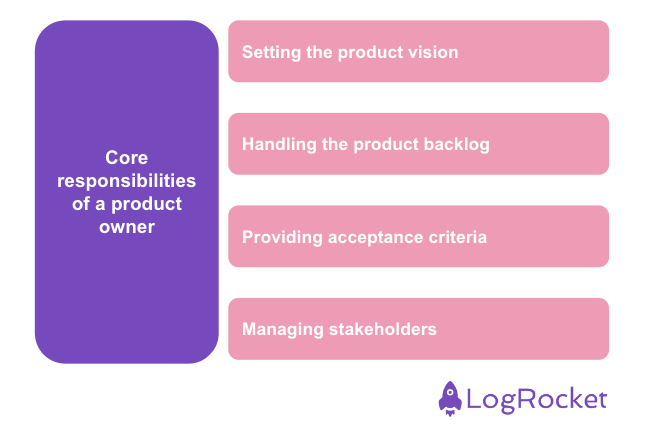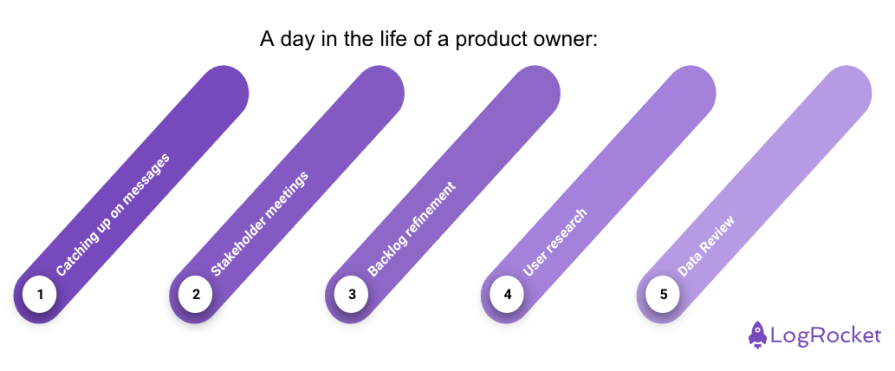The product owner (PO) has one of the most critical roles in the product development lifecycle. They set the direction, keep the team focused, and ensure that the product becomes a source of value for both customers and the business.

In this article, you’ll learn more about a product owner’s core responsibilities, what a typical day in their life looks like, and what skills are essential to get the job done.
The primary responsibilities of a product owner include:

However, keep in mind that a product owner’s exact scope of responsibilities will differ per company culture, size, and type, so treat the list with a grain of salt.
The most important part of the product owner’s job is to set and maintain a strong product vision. You won’t build the next Spotify or Amazon by blindly prioritizing features or listening to customer requests. You must understand what’s going on in your market category and which strategic direction the product should take to differ from competitors.
There’s always more to be done — more ideas, bugs, requests, etc. — than your team can deliver. It’s the product owner’s job to ruthlessly prioritize, regularly say no, and ensure only the most valuable items make it to the backlog.
To work effectively, the team must know what they need to build. Although initially, you might need very detailed, prescriptive product requirement documents, some of the best product owners I’ve worked with mastered the art of guiding acceptance criteria, that is, giving enough details to ensure alignment but leaving the team room to make decisions themselves.
The bigger the company gets, the more people will want their say regarding product direction and what to build next. A skilled product owner uses this as an opportunity to elicit different perspectives and mold them into a singular vision with the biggest chance to win while ensuring everyone feels heard and respected. Trust me, that’s harder than it sounds!
It’s practically impossible to describe a “common day” of a PO. It really depends on where the product or a feature is in its development lifecycle and the challenges the company faces at a given moment.
To make it more practical, let me instead describe a list of activities that each product owner does at least once a week. If you are a PO, odds are your days are built primarily with these blocks:

As unsexy as it sounds, catching up on messages and answering different inquiries is a standard part of the job. After all, a product owner is a communication facilitator in their product area.
I usually book ten minutes for “Slack catch-up” every eighty minutes or so to answer people’s doubts and questions.
The best way to manage stakeholders is to talk to them regularly. It could take the form of weekly open-for-all slots, continuous 1-1s with key stakeholders, or any other way of alignment you prefer.
The more aligned with your stakeholders you are, the easier your professional life will be.
There’s the saying, “Show me your backlog and I’ll tell you what type of product owner you are.” It makes sense since a clear and well-prioritized backlog usually leads to efficient development, whereas an unorganized backlog leads to chaos and confusion.
Backlog refinement can take many forms, such as
Most product owners spend between twenty and forty percent of their capacity on that task alone.
Understanding your user needs and pain points is crucial in building a product that truly resonates with your user. Whether it’s interviews, surveys, or other continuous discovery habits, great POs interact with users weekly.
It’s crucial for product owners to be on top of essential quantitative data, such as patterns of behavior users represent or the health of business KPIs. That’s the best way to understand which initiatives are moving the needle.
Now that we have covered the core responsibilities of a product owner and what a day in life can look like, let’s look at what skills are needed to succeed in the role.
On a high level, there are four main buckets of skills:
Building a great product for users is one thing. Making sure it generates profit is another.
Business acumen includes sub-skills such as:
Mastering these skills gives you a completely new perspective. You’ll be able to identify great ideas for users that simply won’t work for business, as well as ideas that might sound boring from the user’s perspective, but might actually increase revenue greatly.
Whether you like it or not, the more your product earns, the more resources you’ll get to develop it further.
Quantitative data is a double-edged sword. It can give you game-changing insights and learnings about your product and market. Still, it’s also easy to misinterpret the data or accidentally data fish, that is, look only at data that conform to your beliefs.
Fear not; no need to learn R or even SQL. I usually recommend two steps to improve data skills:
Not only will it make you more independent, but understanding how the sausage is made also helps you interpret charts and insights better.
The quality of your product depends on the quality and quantity of your insights. The more insights you can work with as a product owner, the better.
On the one hand, the better you organize your discovery process, the more insights you’ll get. On the other hand, even doing a hundred interviews a week will give you poor results if you can’t ask the right questions or eliminate common biases.
If you want to upskill your continuous discovery game, I highly recommend Product Talk.
Managing relationships across the company is a crucial part of the job. No doubt, people skills are a must-have.
By “people skills” I mean a set of skills and tools that can help you:
As a starting point, I recommend these two books:
But most importantly, ask people you work with for feedback. I like to set quarterly coffee chats during which I chat about my collaboration with the other person and try to get as much feedback as possible.
A product owner plays a critical role in the product development lifecycle. They ensure that
To do so, they continuously meet with stakeholders, conduct user research and data review sessions, plan work with their team, maintain the backlog, and, well, yes, also write a lot of emails.
One must combine business acumen, data literacy, continuous discovery, and people skills to excel in this role. Although I could keep mentioning things like scrum, technical knowledge, and marketing, I believe these four areas are the 20 percent of skills that lead to 80 percent of the results.
At the end of the day, product owner is a challenging, yet a gratifying role.
Featured image source: IconScout

LogRocket identifies friction points in the user experience so you can make informed decisions about product and design changes that must happen to hit your goals.
With LogRocket, you can understand the scope of the issues affecting your product and prioritize the changes that need to be made. LogRocket simplifies workflows by allowing Engineering, Product, UX, and Design teams to work from the same data as you, eliminating any confusion about what needs to be done.
Get your teams on the same page — try LogRocket today.

A practical guide for PMs who want to stop being bottlenecks, delegate smarter, and lead teams effectively with a clear ownership framework.

Stop letting unreliable data block features. Treat data as inventory to track quality, ownership, and ship with confidence.

Learn why slide decks slow teams down and explore better tools like whiteboards, PRDs, and prototypes to improve collaboration and alignment.

AI PM roles are evolving fast. Learn the five types of AI PMs, the skills they need, and how they shape AI products across industries.